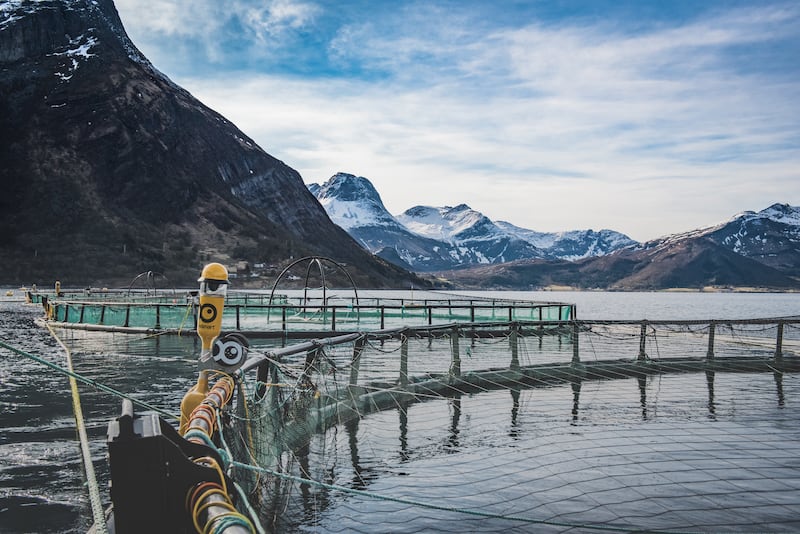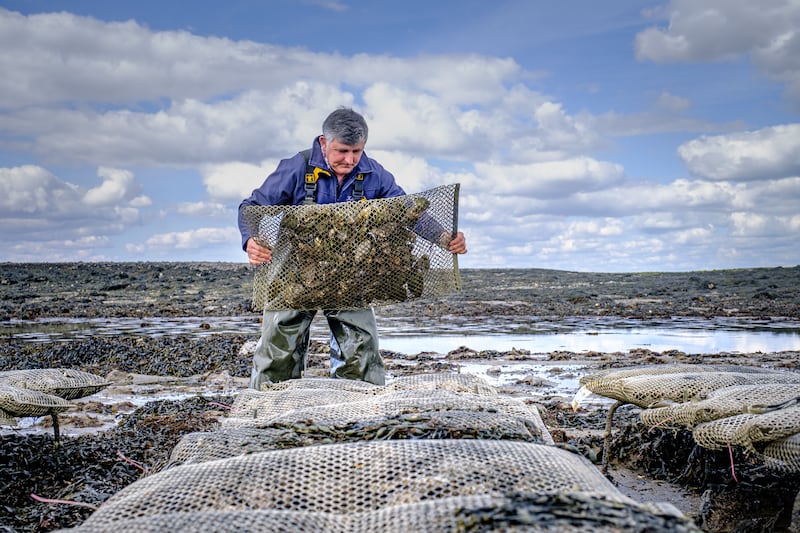Almost 20 years ago, Ireland’s potential as a pioneer in aquaculture technology was being talked up in the way opportunities in offshore wind are now.
Australian marine biologist Neil Sims recalls a conference here on “farming the deep blue” where he says international participants were “blown away” by the enthusiasm and innovative spirit of their Irish counterparts.
It was 2004, and a report commissioned by Bord Iascaigh Mhara (BIM) and the Marine Institute for the conference had made an “overwhelming” case for developing and expanding offshore aquaculture.
It quoted UN Food and Agriculture Organisation estimates that the demand for fishery products would rise to 180 million tonnes by 2030 – representing a 40 per cent increase on the 130 million tonnes available in 2001 from the capture and aquaculture fisheries.
The Wardrobe Department by Elaine Garvey: Evocation of youthful self-discovery is well wrought and truthful
What time is kick-off and what TV channel is Wales v Ireland on? All you need to know about the Six Nations clash
The Movie Quiz: How many actors have received Oscar nominations for Star Wars films?
One of the report’s key conclusions was that finfish farming must move offshore for environmental reasons, including reduced impact on wild fisheries inshore. At that stage, the Clare Island offshore fish farm in Co Mayo was setting premium prices to market an “organic” product.
However, the report said “the multifaceted technological challenge of successfully moving finfish farming offshore is too great for any single company or indeed any single country to address” – and it recommended that an international body should be formed as quickly as possible to progress it.
“I’d like to know what happened in Ireland since then,” says Sims, speaking from Hawaii, where his company, Ocean Era, has developed what is described as the first integrated hatchery and open ocean fish farm in North America.
Sims, a specialist in applied marine research, has worked for a series of start-ups at the Natural Energy Laboratory of Hawaii (NELHA), and founded commercial offshore farms in Hawaii and Mexico to cultivate kampachi or yellowtail, a type of domesticated alternative to wild tuna.
He is one of the key speakers at a conference in Killarney, Co Kerry, on October 19th, hosted by BIM, on “aquatech”, as in the use of technology in the production and farming of seafood.
“In the offshore aqua-technology space, I cannot think of one single innovation that has come out of Ireland in the last 20 years,” says Sims.
There are 22,000 other marine species apart from salmon, and an abundance of species that we could be farming
“It strikes me as disappointing, when the world desperately needs sustainable aquaculture, and when a number of leading environmental groups which had been having pitched battles over fish farming 20 years ago in the US now recognise that blue food is required and that a global climate crisis requires a softer planetary footprint.”
Part of the answer to Sims’s question can be traced to an EU ruling in 2007, three years after that “farming the deep blue” conference hosted by BIM. The EU found Ireland to have contravened environmental regulations in relation to aquaculture by issuing licences in special areas of conservation.
Previously granted licences were permitted to remain while the Marine Institute was charged with conducting environmental impact assessments. An ambitious project rolled out in 2011 by BIM to build a 15,000-tonne fish farm off Inis Oírr in Galway Bay was opposed by angling and environmental groups, with State agency Inland Fisheries Ireland predicting a 40 per cent reduction in returns of wild salmon due to the risk of sea lice associated with the farm if built.
BIM withdrew the plan, after a Government strategic plan capped offshore fish farms to 5,000-7,000 tonnes in 2015. When Mowi was granted a licence for the first new salmon farm in Irish waters in 17 years in 2021, both supporters and opponents of that Bantry Bay project agreed that Ireland’s licensing system was not fit for purpose.
A new Government strategic plan for sustainable aquaculture to 2030 published earlier this month by Minister for Marine Charlie McConalogue paints an optimistic picture in spite of the many conflicts, stating that aquaculture in Ireland has grown from a “cottage industry in the 1980s” to a sector producing about 40,000 tonnes of “high value finfish and shellfish”, employing about 1,800 people.
Aquaculture is “a major contributor to national seafood production and food security”, the Government plan says, and among its 58 recommendations there is a commitment to “investigate the establishment of an aquaculture innovation centre”.BIM has been working on innovation in the sector for the past four to five years with venture capital company Hatch Blue.
“We are limited in our capacity here to expand finfish production,” says BIM development and Innovation director Richard Donnelly. “However, we do have a knowledge base going back to those first fish farms in the 1980s to work on innovations for the fastest-growing protein sector in the world.”
The conference aims to pool that knowledge with speakers such as Sims, whose work with aquaculture start-ups has been assisted by the Natural Energy Laboratory of Hawaii. Sims says it is a type of “entrepreneurial sandbox”, where ideas can be tried and tested, and he advocates its value in coastal states like Ireland.
“There are 22,000 other marine species apart from salmon, and an abundance of species that we could be farming,” he adds.

Jennifer Bushman, a sustainable seafood expert, communicator, and strategist also speaking at the BIM conference, agrees. She is a proponent of integrated “multi-trophic” systems where finfish, seaweed and bivalves can be farmed on one site.
Bushman sits on the board of Oceans 2050, the campaign for ocean health founded by Jacques Cousteau’s granddaughter Alexandra. She is also chief marketing officer with a Norwegian third-generation family-run aquaculture company, Kvarøy Arctic.
Based on an island of the same name, where the cruise ship Hurtigruten regularly stops, the company is a model of sustainable practise with a commitment to transparency, she says.
“What makes Kvarøy Arctic stand out among the rest is the family’s philosophy of pride – from the quality of the salmon and commitment to caring for the environment,” says Bushman.
She believes its approach is helping to “redefine” a finfish industry which, she is convinced, has a future if there is both transparency and tight regulation. Coming from a cattle ranching background, she believes world population increase means the ocean, rather than land, represents the future for growing food demands.
Norway, world leader in production of farmed Atlantic salmon and rainbow trout, has been investing in land-based fish farms with mixed results. This involves using recirculating aquaculture systems (RAS) technology where water used in production is recycled, and flow-through systems where seawater is continuously pumped into a production facility.
“The jury is still out on the success of this, given the high energy costs,” says Bushman. “Its viability also depends on location and species.”
Sims agrees that land-based systems are “very energy intensive at time when we are moving into an energy-constrained epoch”.
His research has focused on the potential of the open ocean. A spin-off company named Forever Oceans has been working in partnership with Lockheed Martin to rear fish in 2,000m of deepwater.
The equipment fitted with single-point mooring, sensors and software to adjust feed allows the pen to drift with the currents. Stock is said to be healthier, and the waste is less a pollutant and more a “fertiliser”, according to Forever Oceans – which says the fish are living “almost as if they are in the wild”.
The impact of warmer seawaters

The current marine heatwave encapsulates one of the most pressing technological challenges for aquaculture in Irish waters, according to both operators and groups like Friends of the Irish Environment (FIE).
Warmer waters, jellyfish, parasites and disease could “empty the deepest pockets”, according to FIE’s Tony Lowes, who says the group has never been opposed to sustainable fish farming.
Galway Bay oyster farmer Diarmuid Kelly was extremely concerned when water temperatures rose in June from 16 to 21 degrees. For him, a most pressing “aquatech” need is to develop an early warning system for temperature rises.
“We had mortality, and so we stopped grading and handling that month to reduce the stress on the stock,” says Kelly. “It was all we could do, and we have had a very busy summer where we have benefited from a lot of good quality tourism.”
Kelly’s company is a stakeholder in south Galway Bay environmental group Cuan Beo, and it is currently working with the Marine Institute on system that can issue advance alerts about both temperature rise and salinity changes.
The “BioDiver Coast” coastal pilot project also involves Nologin Ocean Weather Systems, which draws on numerical modelling and artificial intelligence for ocean-atmospheric forecasting and climate monitoring services.





















